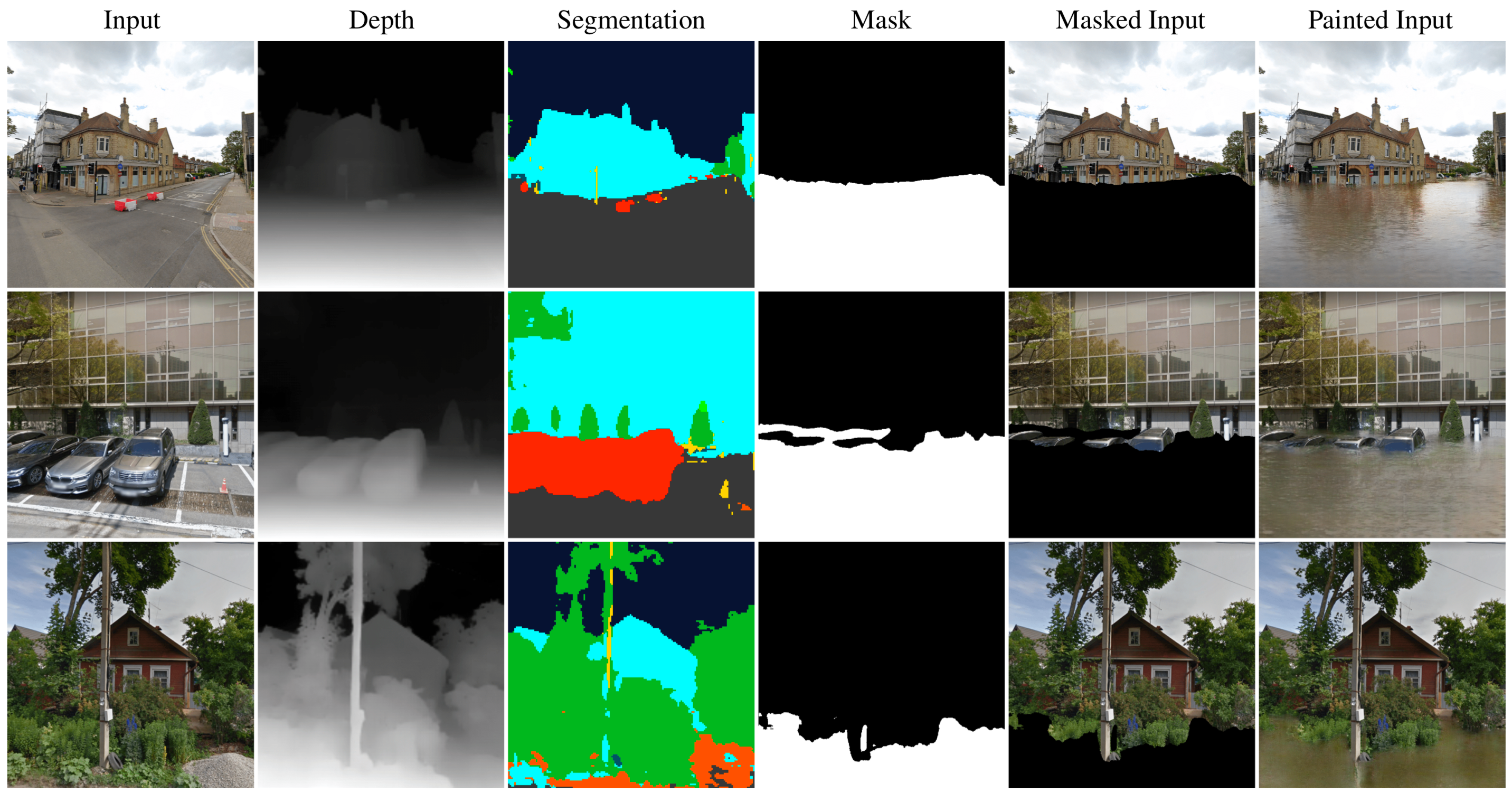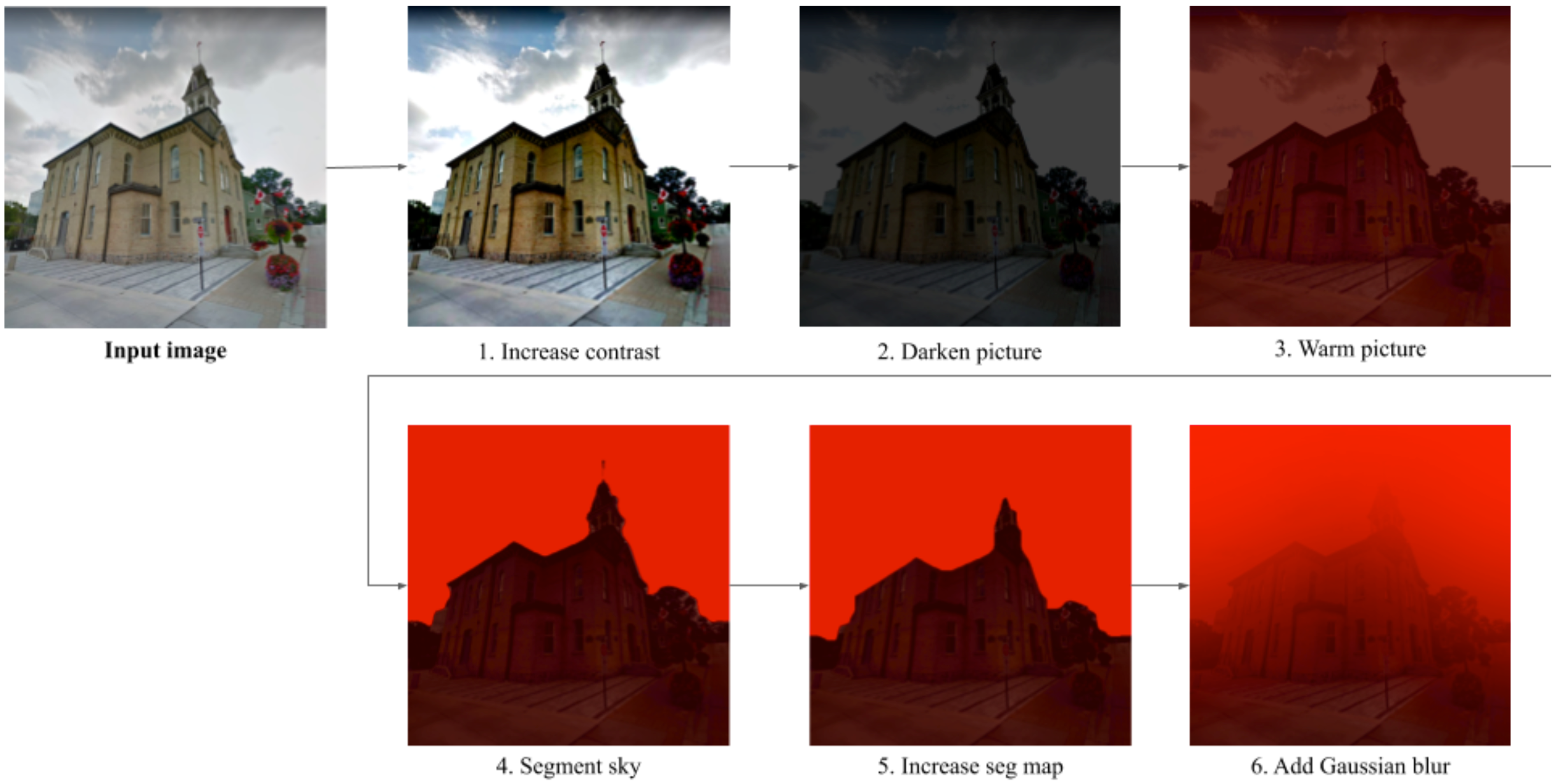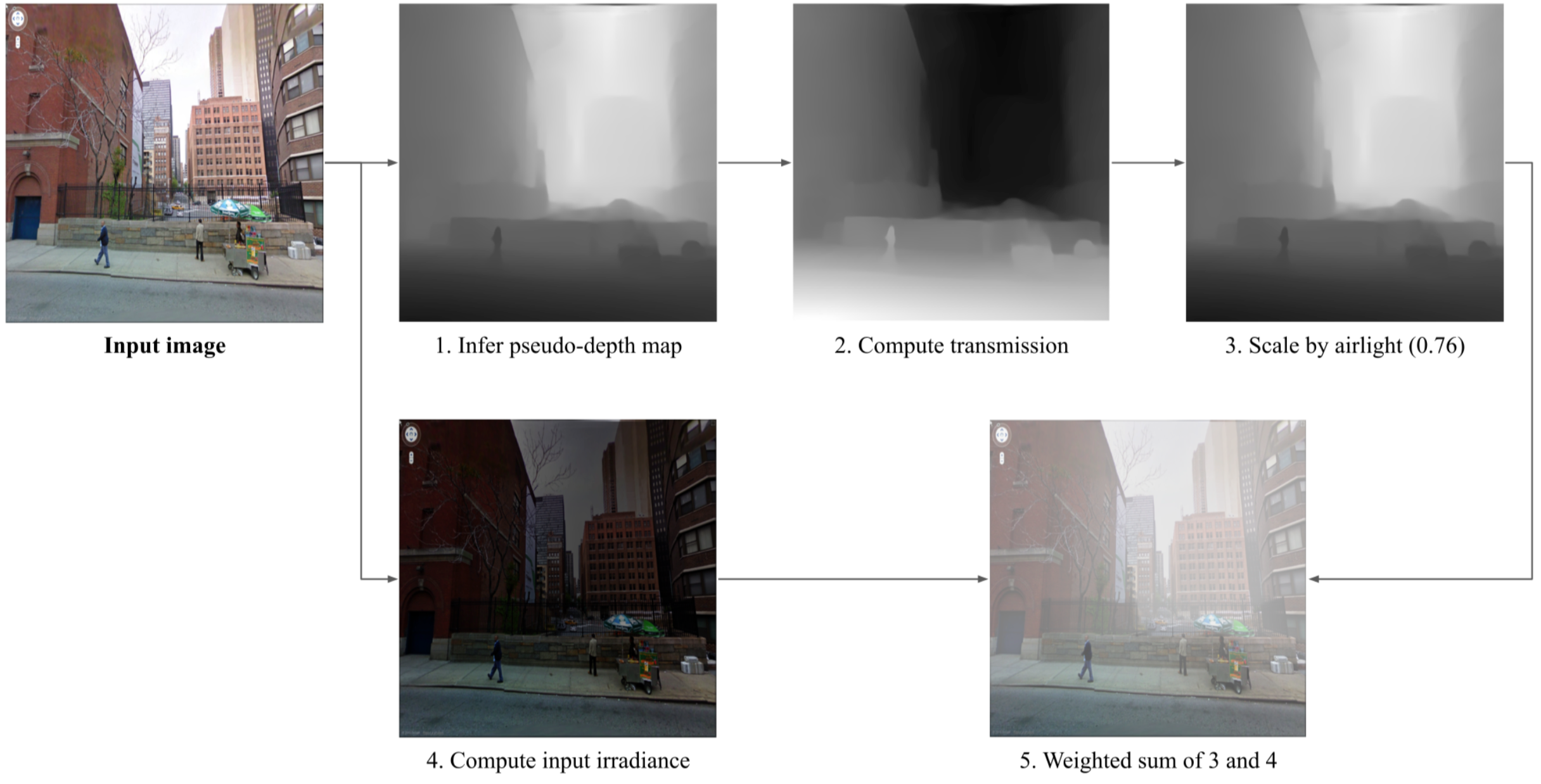language:
- en
tags:
- Climate Change
- GAN
- Domain Adaptation
license: gpl-3.0
title: ClimateGAN
emoji: 🌎
colorFrom: blue
colorTo: green
sdk: gradio
sdk_version: 3.6
app_file: app.py
inference: true
pinned: true
ClimateGAN: Raising Awareness about Climate Change by Generating Images of Floods
This repository contains the code used to train the model presented in our paper.
It is not simply a presentation repository but the code we have used over the past 30 months to come to our final architecture. As such, you will find many scripts, classes, blocks and options which we actively use for our own development purposes but are not directly relevant to reproduce results or use pretrained weights.
If you use this code, data or pre-trained weights, please cite our ICLR 2022 paper:
@inproceedings{schmidt2022climategan,
title = {Climate{GAN}: Raising Climate Change Awareness by Generating Images of Floods},
author = {Victor Schmidt and Alexandra Luccioni and M{\'e}lisande Teng and Tianyu Zhang and Alexia Reynaud and Sunand Raghupathi and Gautier Cosne and Adrien Juraver and Vahe Vardanyan and Alex Hern{\'a}ndez-Garc{\'\i}a and Yoshua Bengio},
booktitle = {International Conference on Learning Representations},
year = {2022},
url = {https://openreview.net/forum?id=EZNOb_uNpJk}
}
Using pre-trained weights from this Huggingface Space and Stable Diffusion In-painting
- Download code and model
git lfs install
git clone https://huggingface.co/vict0rsch/climateGAN
git lfs pull # optional if you don't have the weights
- Install requirements
pip install requirements.txt
- Enable Stable Diffusion Inpainting by visiting the model's card: https://huggingface.co/runwayml/stable-diffusion-inpainting and running
$ huggingface-cli login - Run
$ python climategan_wrapper.py helpfor usage instructions on how to infer on a folder's images. - Run
$ python app.pyto see the Gradio app.- To use Google Street View you'll need an API key and set the
GMAPS_API_KEYenvironment variable. - To use Stable Diffusion if you can't run
$ huggingface-cli login(on a Huggingface Space for instance) set theHF_AUTH_TOKENenv variable to a Huggingface authorization token - To change the UI without model overhead, set the
CG_DEV_MODEenvironment variable totrue.
- To use Google Street View you'll need an API key and set the
For a more fine-grained control on ClimateGAN's inferences, refer to apply_events.py (does not support Stable Diffusion painter)
Note: you don't have control on the prompt by design because I disabled the safety checker. Fork this space/repo and do it yourself if you really need to change the prompt. At least open a discussion.
Using pre-trained weights from source
In the paper, we present ClimateGAN as a solution to produce images of floods. It can actually do more:
- reusing the segmentation map, we are able to isolate the sky, turn it red and in a few more steps create an image resembling the consequences of a wildfire on a neighboring area, similarly to the California wildfires.
- reusing the depth map, we can simulate the consequences of a smog event on an image, scaling the intensity of the filter by the distance of an object to the camera, as per HazeRD
In this section we'll explain how to produce the Painted Input along with the Smog and Wildfire outputs of a pre-trained ClimateGAN model.
Installation
This repository and associated model have been developed using Python 3.8.2 and Pytorch 1.7.0.
$ git clone [email protected]:cc-ai/climategan.git
$ cd climategan
$ pip install -r requirements-3.8.2.txt # or `requirements-any.txt` for other Python versions (not tested but expected to be fine)
Our pipeline uses comet.ml to log images. You don't have to use their services but we recommend you do as images can be uploaded on your workspace instead of being written to disk.
If you want to use Comet, make sure you have the appropriate configuration in place (API key and workspace at least)
Inference
- Download and unzip the weights from this link (checkout
gdownfor a commandline interface) and put them inconfig/
$ pip install gdown
$ mkdir config
$ cd config
$ gdown https://drive.google.com/u/0/uc?id=18OCUIy7JQ2Ow_-cC5xn_hhDn-Bp45N1K
$ unzip release-github-v1.zip
$ cd ..
Run from the repo's root:
- With
comet:
python apply_events.py --batch_size 4 --half --images_paths path/to/a/folder --resume_path config/model/masker --upload- Without
comet(and shortened args compared to the previous example):
python apply_events.py -b 4 --half -i path/to/a/folder -r config/model/masker --output_path path/to/a/folder- With
The apply_events.py script has many options, for instance to use a different output size than the default systematic 640 x 640 pixels, look at the code or python apply_events.py --help.
Training from scratch
ClimateGAN is split in two main components: the Masker producing a binary mask of where water should go and the Painter generating water within this mask given an initial image's context.
Configuration
The code is structured to use shared/trainer/defaults.yaml as default configuration. There are 2 ways of overriding those for your purposes (without altering that file):
By providing an alternative configuration as command line argument
config=path/to/config.yaml- The code will first load
shared/trainer/defaults.yaml - then update the resulting dictionary with values read in the provided
configargument. - The folder
config/is NOT tracked by git so you would typically put them there
- The code will first load
By overwriting specific arguments from the command-line like
python train.py data.loaders.batch_size=8
Data
Masker
Real Images
Because of copyrights issues we are not able to share the real images scrapped from the internet. You would have to do that yourself. In the yaml config file, the code expects a key pointing to a json file like data.files.<train or val>.r: <path/to/a/json/file>. This json file should be a list of dictionaries with tasks as keys and files as values. Example:
[
{
"x": "path/to/a/real/image",
"s": "path/to/a/segmentation_map",
"d": "path/to/a/depth_map"
},
...
]
Following the ADVENT procedure, only x should be required. We use s and d inferred from pre-trained models (DeepLab v3+ and MiDAS) to use those pseudo-labels in the first epochs of training (see pseudo: in the config file)
Simulated Images
We share snapshots of the Virtual World we created in the Mila-Simulated-Flood dataset. You can download and unzip one water-level and then produce json files similar to that of the real data, with an additional key "m": "path/to/a/ground_truth_sim_mask". Lastly, edit the config file: data.files.<train or val>.s: <path/to/a/json/file>
Painter
The painter expects input images and binary masks to train using the GauGAN training procedure. Unfortunately we cannot share openly the collected data, but similarly as for the Masker's real data you would point to the data using a json file as:
[
{
"x": "path/to/a/real/image",
"m": "path/to/a/water_mask",
},
...
]
And put those files as values to data.files.<train or val>.rf: <path/to/a/json/file> in the configuration.
Coding conventions
- Tasks
xis an input image, in [-1, 1]sis a segmentation target withlongclassesdis a depth map target in R, may be actuallylog(depth)or1/depthmis a binary mask with 1s where water is/should be
- Domains
ris the real domain for the masker. Input images are real pictures of urban/suburban/rural areassis the simulated domain for the masker. Input images are taken from our Unity worldrfis the real flooded domain for the painter. Training images are pairs(x, m)of flooded scenes for which the water should be reconstructed, in the validation data input images are not flooded and we provide a manually labeled maskmkittiis a specialsdomain to pre-train the masker on Virtual Kitti 2- it alters the
trainer.loadersdict to select relevant data sources fromtrainer.all_loadersintrainer.switch_data(). The rest of the code is identical.
- it alters the
- Flow
- This describes the call stack for the trainers standard training procedure
train()run_epoch()update_G()zero_grad(G)get_G_loss()get_masker_loss()masker_m_loss()-> masking lossmasker_s_loss()-> segmentation lossmasker_d_loss()-> depth estimation loss
get_painter_loss()-> painter's loss
g_loss.backward()g_opt_step()
update_D()zero_grad(D)get_D_loss()- painter's disc losses
masker_m_loss()-> masking AdvEnt disc lossmasker_s_loss()-> segmentation AdvEnt disc loss
d_loss.backward()d_opt_step()
update_learning_rates()-> update learning rates according to schedules defined inopts.gen.optandopts.dis.opt
run_validation()- compute val losses
eval_images()-> compute metricslog_comet_images()-> compute and upload inferences
save()



